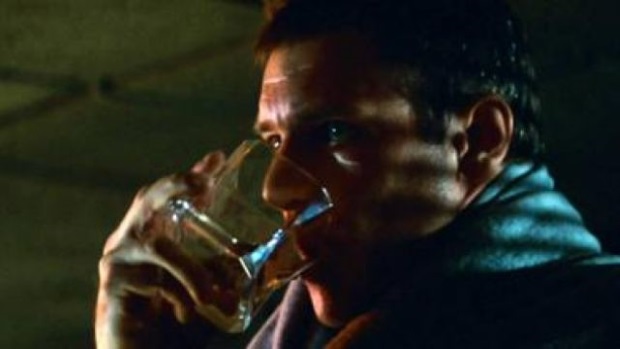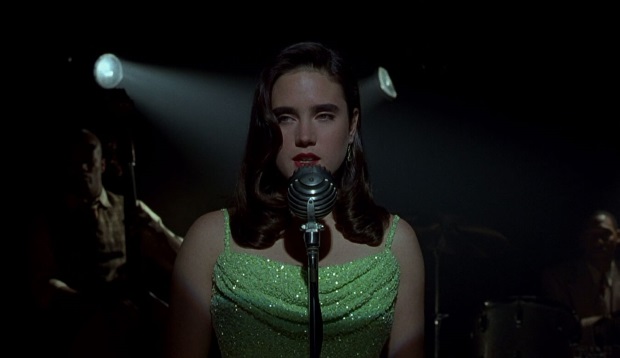The depiction of alcohol and addiction in science fiction
Den Of Geek's Aliya Whiteley starts a guest series for us, looking at addictions in science fiction. Part one? It's all about alcohol...
Crime and science fiction fit together so well, and maybe that’s because it’s possible to use both genres without sacrificing any of the best parts; nothing needs to get left out. Science fiction is all about big ideas and vast narratives. Bringing a crime – and an interesting detective to solve it, of course – into that landscape only works in its favour, giving a personal, human angle that we can understand no matter how strange the location or the technology gets.
It’s depressing to think that crime, out of all genres, would work the best at humanising possible futures. It brings to mind a scene from a sci-fi film that contains many noir elements: The Matrix (1999). Agent Smith tells Neo that the first Matrix was designed as a utopia, but people wouldn’t accept that as a convincing version of reality. He says, “I believe that, as a species, human beings define their reality through suffering and misery.”
I’m not sure about preferring reality that way, but there’s an argument to be made that we expect our stories to contain suffering and misery, and to make sci-fi worlds recognisable we often utilise problems that we recognise from our own social reality.
Addiction, in many forms, plays a part in these stories. Noir heroes move through worlds that are filled with those who turn to substances, legal or otherwise, to get through the long days and longer nights. The noir genre is infused with the haze of alcohol, the smoke of cigarettes, and sometimes something stronger. This series of articles will take a look at how SF noir uses addiction in different ways to make the worlds of imagination seem more human, starting with a glass of beer or a shot of whisky, or maybe something more surprising…
What would noir be without a bar or a nightclub for a detective to get drunk in, or a femme fatale to croon in? It’s no different in science fiction – every franchise has its drinking spot, from Star Wars to Star Trek. The best of the sci-fi noir bunch offer style, shadiness, a touch of seediness on occasion, and something to say about the world they’re depicting. Although I should start off by pointing out that it can be the drinking receptacle rather than the alcohol itself that sets up the audience for what’s about to follow.

I remember the first time I watched Blade Runner (1982), and the scene that stuck in my mind was Rick Deckard in his apartment, drinking quietly while enhancing an image on a screen to search for clues to the whereabouts of the replicants he seeks. He holds a chunky, square glass in his hand; I don’t think I’d seen anything like it before (Were all drinking glasses really boring in the early ‘80s, or was that only the ones in my house?). It proved we were in a different world, a future aesthetic, as completely as the vast cityscape shots.
Establishing a style to the future is such an important part of science fiction. Altered Carbon (both the 2001 novel and the 2018 television series) includes a lot of different places to drink, and each one has its own personality. That’s literally the case in the Midnight Lamp Bar, which is part of the Raven Hotel, run by an artificial intelligence. Author Richard Morgan describes the walls as, “festooned with a variety of clock faces…interwoven with every form of lamp known to man, from clay prehistoric to enzyme decay light canisters.” The characters drink their vodka and whisky surrounded by so many different faces, in so many different lights. It’s the perfect image for a story where you might change your own face at times.
Another example of bar décor that speaks a thousand words can be found in Dark City (1998). Jennifer Connelly works as a club singer; the camera alternates between showing us her sleepy, almost hypnotised, expression as she sings and a long shot of the nightclub she’s serenading. Behind the bar there are rows and rows of empty glasses, lined up symmetrically. It’s a clue that there’s something missing from this city – it’s a profoundly empty experience, for reasons we come to understand later.

Off-planet drinking is also an option, and space bars have become the place in which to mingle after long shifts in mining, for instance. There’s usually a lot of neon and lasers, some synth-pop playing, and unusual background characters dotted around the place who stare in an unfriendly manner at the protagonist and possibly get into a fight with him. What’s interesting about these scenes is that they feel like they’re lifted wholesale from another genre altogether: the western. They’re variations on the lawless town in the Wild West, and the bar is the home of the rough tough cowboy element of the space station/planet. In Outland (1981) Sean Connery’s character is obviously the equivalent of the Sherriff in this environment; in fact, his official title is Federal Marshal. There’s a great scene where he enters the bar to get a drink and everyone falls silent, watching him, until he’s slowly taken his seat and started drinking his beer. It could have come straight out of a John Wayne movie.
For a more recent version, try The Expanse (2015), based on the books by James A. Corey. It includes a noir strand that features a hat-wearing, wise-cracking detective called Joe Miller with a bleak outlook on life (there’s even a back-story for the hat this time around). Miller can often be found propping up bars in space stations, and The Expanse has a way of making the drinks and the glasses look interesting, but not bizarre. It’s a series that has its own visual appeal, right down to the smallest details, without ever feeling disconnected from reality. Perhaps that’s what including a bar scene does for an adventure set in space – it manages to find some aspect that feels like familiar and believable territory to us all.
But back in the here and now, even Marvel’s superheroes have also had their problems with addiction.
Jessica Jones is a private investigator and PTSD sufferer who relies on alcohol to help her get through the day. It’s the same old hard-drinking detective that we find in noir stories, but from a different angle that makes for some very affecting scenes. In episode eight of the first series she sits down for dinner with Kilgrave, the man who systematically used his own mind control powers on her for months. She refuses to eat but she downs glass after glass of red wine, all the time daring him to command her to stop. It’s the only act of rebellion open to her, and the look on his face as she rejects his notion of having a pleasant dinner together, deciding to get blind drunk instead, makes for a really powerful scene that reveals there are still new angles to explore in noir.
Part Two of SF Noir Addictions will explore cigarettes in science fiction detective films, television series and novels.